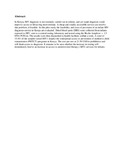| dc.contributor.author | Khamadi, S | |
| dc.contributor.author | Okoth, V | |
| dc.contributor.author | Lihana, R | |
| dc.contributor.author | Nabwera, J | |
| dc.contributor.author | Hungu, J | |
| dc.contributor.author | Okoth, F | |
| dc.contributor.author | Lubano, K | |
| dc.contributor.author | Mwau, M | |
| dc.date.accessioned | 2013-06-13T07:31:53Z | |
| dc.date.available | 2013-06-13T07:31:53Z | |
| dc.date.issued | 2008 | |
| dc.identifier.citation | J Trop Pediatr. 2008 Dec;54(6):370-4. | en |
| dc.identifier.uri | http://www.ncbi.nlm.nih.gov/pubmed/18511477 | |
| dc.identifier.uri | http://erepository.uonbi.ac.ke:8080/xmlui/handle/123456789/32747 | |
| dc.description.abstract | In Kenya, HIV diagnosis is not routinely carried out in infants, and yet rapid diagnosis could improve access to lifesaving interventions. A cheap and readily accessible service can resolve this problem, if feasible. In this pilot study the feasibility and costs of provision of an infant HIV diagnosis service in Kenya are evaluated. Dried blood spots (DBS) were collected from infants exposed to HIV, sent to a central testing laboratory and tested using the Roche Amplicor v. 1.5 DNA PCR kit. The results were then dispatched to health facilities within a week. A total of 15.4% of the samples tested HIV+ despite the widespread access to prevention of mother to child transmission (PMTCT) programs in Kenya. The cost per test at 21.50 USD is prohibitive and will limit access to diagnosis. It remains to be seen whether the increase in testing will immediately lead to an increase in access to antiretroviral therapy (ART) services for infants. | en |
| dc.language.iso | en | en |
| dc.title | Rapid identification of infants for antiretroviral therapy in a resource poor setting: the Kenya experience. | en |
| dc.type | Article | en |
| local.publisher | Center for Virus Research, Kenya Medical Research Institute, Nairobi, Kenya | en |

